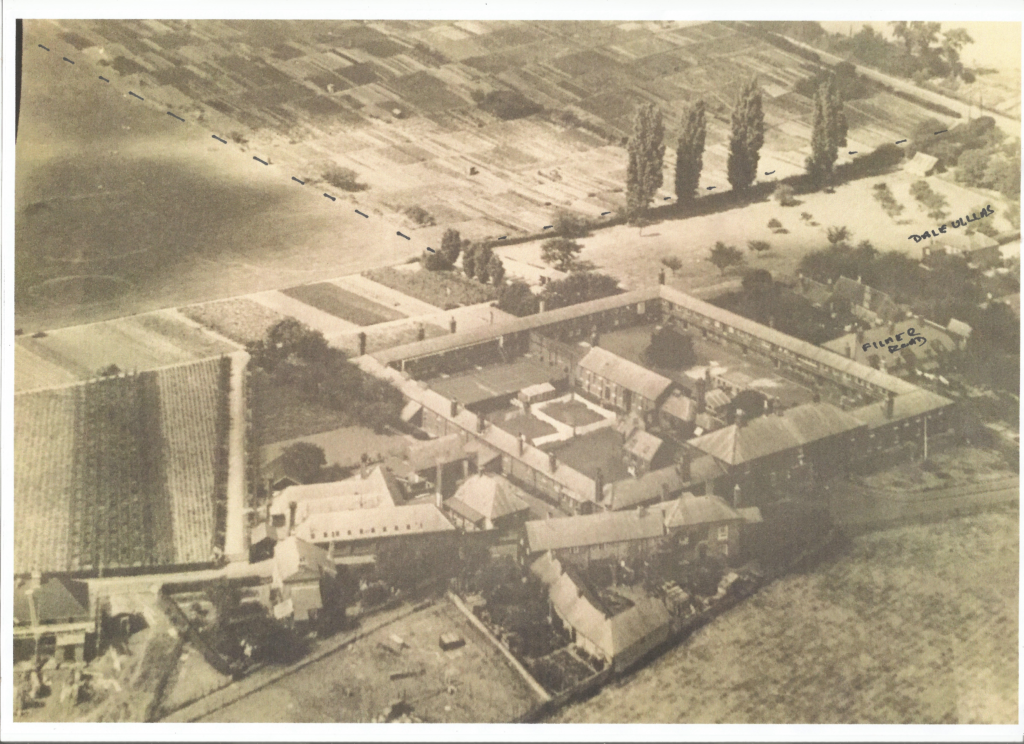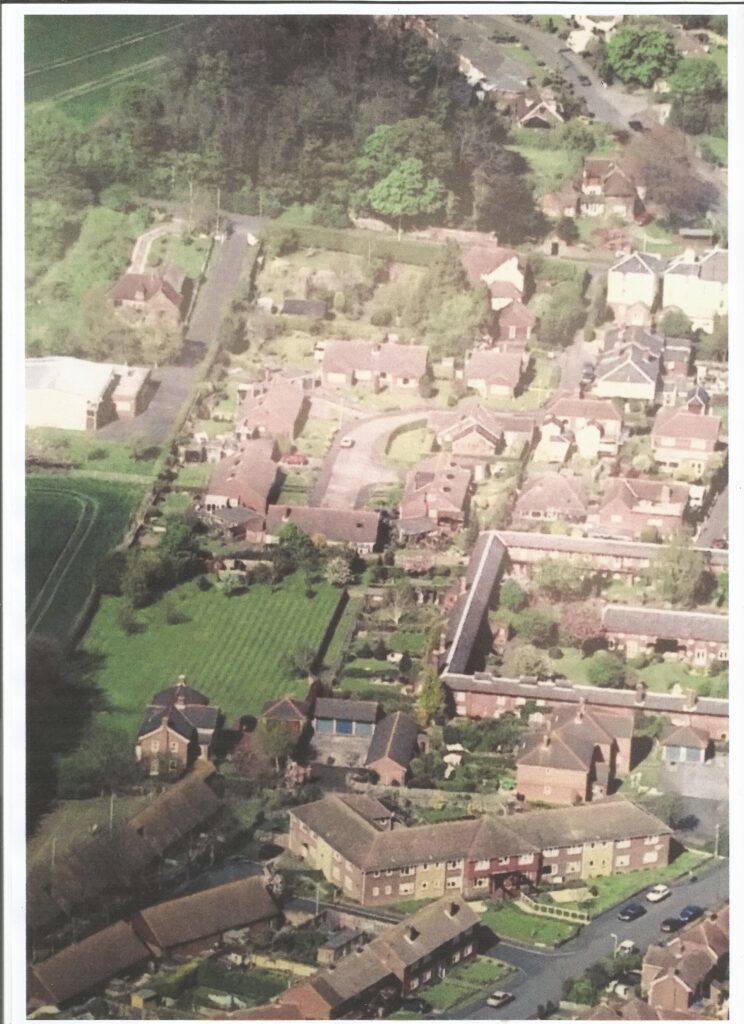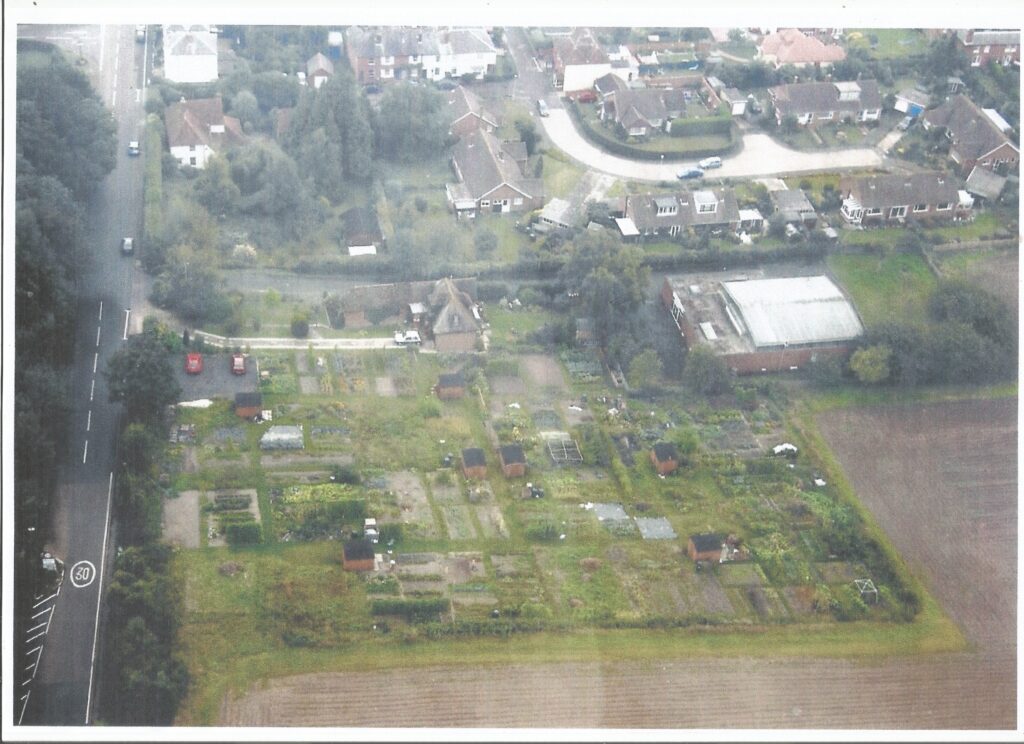History of the Association
The land on which our present allotments are situated belongs to Cantley Estates, and, along with the playing field and children’s play centre adjacent to Bridge Health Centre are leased by the Parish Council from Cantley Estates.
I do not know when the Bridge allotments first started, but the Small Holdings and Allotments Act of 1908 required a local authority to maintain an adequate provision to provide land for allotments. However, Bridge certainly had allotments well before the World Wars.

The first is a black and white photo dated 1938 and shows the extent of the allotments at that time.
In the centre of the picture is The Close, originally built as a Workhouse in 1835, with the main entrance onto Union Road. The Close later became a nursing home and home for the elderly, before being converted into housing in the 1980s, when the New Close, now named Bridge Haven, was built in Conyngham Lane.
The four tall trees behind and to the right of The Close mark the boundary between the allotments, which stretch to the top of the picture, and to the land currently occupied by the Telephone Exchange, and Dering Close (the approximate boundary of the allotments is marked in black). The entrance to the allotments off the main road is just visible. From this photo it is apparent that the area occupied by the allotments extended at least twice as far into the field as they do at present and were continuous right up to Station Road. You can see that the far end of the allotments is in line with the near end of the Close. I would estimate that at the time this photo was taken the allotments occupied an area six times greater than our present site.
To the right of the Close are the properties in Filmer Road, and on the far right, Dale Villas in Dering Road.

By contrast, the second photo is a colour photo taken about 1990 and shows part of the Close on the right, then Dering Close, the Telephone Exchange, and the Old Telephone Exchange, and the mainly run-down allotments.

The third photo was taken probably about 2005. At that time the farm land adjacent to plots 8,9,10 was still being cultivated. My walk round for this article now shows it to be fenced off from the rest of the field, and no longer cultivated.
By 1970 the area occupied by the allotments had been much reduced and split into two parts, the upper and lower allotments. The 14 plots we now occupy were, before 2003, much larger, and, if my memory is correct, amounted to 7 plots. There was no car park, but in the area of plots 13 and 14 and parts of 11 and 12 Ernie Ovenden had two plots, one for crops, the other nearest the road, for his chickens. A third plot was in plot 10 and part of plot 9. The remaining land was occupied by four more plots. Plot 2, which extended to the access road to the Telephone Exchange, was occupied by a shepherd.
The upper allotments were separated from the lower allotments by the farmer’s field and were accessed through a metal 6 bar gate in Station Road, about 100 yards from the junction with the main road. The area occupied by these upper allotments was roughly 100 yards by 100 yards, with a similar area separating the upper and lower allotments cultivated by the farmer.
Having left deep sea life for a career on the ferries based at Dover and Folkestone in October 1974, I applied for an allotment, but none were available. After a couple of years the area now occupied by the garden of the Old Telephone Exchange, and plot 2, became available. It had been used as a building and rubbish tip when the New Telephone Exchange was built. The rent – £10 a year (£92 in today’s money). The facilities offered, just the plot. No water, no shed, no manure, no mower and petrol, and no committee. The rent payable to an elderly gentleman who lived in the High Street.
There was virtually no contact between the tenants of the upper and lower allotments, but if you venture over the gate in Station Road into what were the upper allotments you will see at least one shed still standing, and a considerable amount of rubble and other items indicating that this ground was used as allotments. There had been a rule book (according to Ernie Ovenden, no digging on a Sunday) but none was available when I started. Ernie also explained that plot holders would call in at Aunt Betsy’s off-licence in Dering Road on their way home for refreshment, sitting in the area now occupied by the front garden of 12, Dering Close.
Certainly on the lower set of allotments, the tenants were all male, many elderly, and as age took its toll, plots became vacant and fell into disrepair. By the year 2000 I remained the last active tenant of the lower allotments, with access along a narrow path cut between the brambles that covered the site to what became plot 2.
In 2003 after much deliberation Cantley Estates and the Parish Council decided to concentrate on the lower set of allotments, and to close down the upper set. The site was cleared (over 4 tonnes of scrap metal were removed) a large bonfire lit to burn all burnable debris, and it burnt for several days, the brambles were grubbed out, and the site was ready for re-opening. The existing sheds were put up by contractors, who also erected the fencing and gates. Craig Dobson and myself laid and connected up the pipework for the mains water supply that we now take for granted, and Pam Dobson sourced the supply of hedging material that now separates the allotments from the field. The hedge was planted by a working party over one weekend.
A committee was formed, and as no-one was prepared to be chairman, Tony Walder, who had been active in pushing for rejuvenating the allotments, took on that role, although he wasn’t a member for a few more years.
Initially, we had a skip on the car park for the collection of large rocks, bricks, etc, that continued to surface as the plots were cultivated.
For the first two years the minutes were hand written by our first secretary Julie Morgan and hand delivered to members. Following Julie in my turn as secretary I used a primitive computer to print the minutes, but again, hand delivered them to members. It was at this time the first set of rules and the tenancy agreements we all sign were produced; a task which took me many hours. The rules have been amended and updated many times since those early days, the tenancy agreements remain unchanged.
The widespread use of the internet and the Bridge Village website, have all made for better communication and the recruitment of new members, only once in the early days did we have a period when there was no-one on the waiting list.
Before the 2003 revamping of the allotments I was the sole active member on the lower allotments, and I think on the upper allotments there were one or two plots still being cultivated. The reason we enjoy our current facilities are due to the way the allotments are run. In the early days after 2003 the committee regularly consisted of seven or eight members, a quorum was, if I remember correctly, numbered at 6 members. Over the subsequent years the falling numbers of members willing to serve on the committee meant that the quorum had to be reduced to four some years ago – my experience in the period from the late 1970s shows that without an active, and well supported committee, there is a risk that, over time the allotments will deteriorate.
For the allotments to remain a successful vibrant community it is essential that members continue to support the running of the site – be on the Committee or taking take in the working parties held during the year.
David Spencer.
April 23rd 2022.